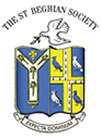|
 |
The Old St Beghian | |
| January 2017 | |||
What’s in a Name?
What is now the Foundation dining hall was part of the original school built in 1587. The oak panelling, however, evidently came as a later adornment. Hundreds of names, dates and other graffiti have been carved into the wood, the earliest dating from the 1720s. Amongst these is a strikingly well carved and large lettered A.H. Fetherstonehaugh. Google tells us that this is a Northumbrian name found most notably in the name of the family that built and owned Featherstone Castle in the Tyne valley. We are also told that over the centuries the spelling of the name has alternated between Featherstonehaugh and Fetherstonehaugh.
Research has revealed the following about this former pupil, Alfred Hardinge Fetherstonehaugh:
- In spite of the Northumbrian origins of his surname, Alfred was born in Ireland.
- He attended St Bees School from 1915-1917 then went on to study medicine at Trinity College, Dublin.
- He enrolled as a cadet pilot in October 1918 and was involved with the RAF until granted a pension in 1922.
- He worked in Malaya before joining the Pioneer Corps as a second lieutenant in January 1942.
- The following month Alfred was captured by the Japanese in Thailand, only being released at the end of the war in 1945.
- He returned to Malaya and became Chief Game Warden for Malaya.
- In March 1950 he left Penang with his (second) wife Phyllis and settled in county Sligo, Ireland.
- He died on February 2nd 1978 aged 71.
Alfred does not appear to have maintained contact with the school, but of course he was only a pupil there for two years and most of his subsequent career was overseas. His admirable career, however, seems to be worth celebrating
A.H. Fetherstonehaugh is only one of a number of interesting surnames that feature on the panelling.
My favourite is J.P. GREENHOUSE.
I have checked all the telephone directories to which I have access in my local library and cannot find a single GREENHOUSE. But what a splendid name!
I have managed to trace both J.P. Greenhouse's nephew and great nephew (oddly both also J.P. Greenhouse), who together send this information about Jack Percy Greenhouse (known throughout the family as 'Uncle Jack').
The youngest of ten children he spent two years at St Bees School just prior to WW1, the only one of the siblings to have done so. Not being an academic, on leaving St Bees he was sent to the colonies to make good, in his case to Canada. Shortly after his arrival, war came and he unhesitatingly answered the call to the flag in early 1915, joining the Canadian Expeditionary Force. He listed among his qualifications, two years in the St Bees School Corps. After four months training, Jack spent twenty-eight months in France, primarily in charge of mules and horses.
At the end of the war he returned to Canada and joined the British Colombia Forestry Service as a ranger. He married a widow with three children and after her death moved to Victoria to live with his widowed brother Frank. I am told that they made an interesting couple – Jack large and gregarious and his brother lean and prim. Jack was always fun to be around and liked whiskey and telling ribald jokes. Frank often scolded his younger brother but they were unfailingly very fond of each other.
Maybe one day a closer study of the panelling will be made. I guess more wonderful gems are waiting to be found!
George Robson (FN 57-64).
Please click here to see photographs.
Home
The St Beghian Society
St Bees School,
St Bees, Cumbria, CA27 0DS.
Tel: (01946) 828093 Email: osb@stbeesschool.co.uk
Web: www.st-beghian-society.co.uk
![]()